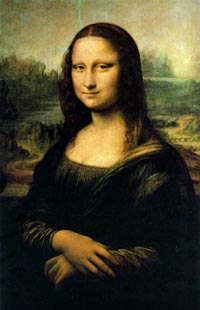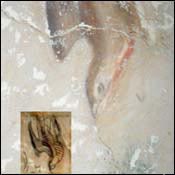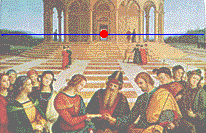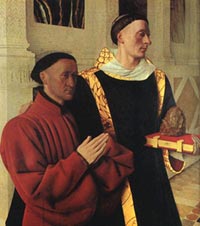| (insert your NIE or newspaper logo here) | Weekly Online LessonOnline Lesson ArchiveGrade Level: 5-9
|
Uncovering Renaissance Secrets
 Mona
Lisa is probably one of the most recognized faces in the world. And,
her portrait's artist, Leonardo da Vinci, is certainly one of the most
famous painters of all time.
Mona
Lisa is probably one of the most recognized faces in the world. And,
her portrait's artist, Leonardo da Vinci, is certainly one of the most
famous painters of all time.
While it is known who created the portrait and when it was completed (around 1507), the specific location of where da Vinci and his subject met and composed the painting has remained a mystery.
Last week, however, officials announced they had uncovered a workshop at a monastery in the heart of Florence, Italy, that could provide evidence this was the place where Mona Lisa became immortalized.
The hidden rooms were discovered during restoration work in a part of the monastery that has been occupied by the Institute of Military Geography over the last century.
The workshop's walls are painted in frescoes characteristic of da Vinci's style, convincing some experts that this is one clue that links this workshop to da Vinci and his students.
 Others
believe the frescoes may have been painted in the mid to late 1500s,
meaning the style would have been relatively common among Renaissance
artists and not necessarily done by da Vinci's hand.
Others
believe the frescoes may have been painted in the mid to late 1500s,
meaning the style would have been relatively common among Renaissance
artists and not necessarily done by da Vinci's hand.
But Leonardo da Vinci was not only an artist, he was also an inventor, writer, and scientist.
In fact, his intense and varied passions exemplified the time period during which he lived -- the Renaissance, 1400 A.D. to 1600 A.D. This period marked a boost in the growth and appreciation of art, architecture, literature, and science, with many individuals contributing to this remarkable era.
During this week's lesson, you will explore Leonardo's workshop and get a glimpse into what it was like to live like an artist in the Renaissance. You'll also discover how other aspects of civilization evolved during the Renaissance and why.
Leonardo's Workshop
 Let's
begin our investigation of the Renaissance by exploring Leonardo's
Workshop at Sanford Art Adventures.
Let's
begin our investigation of the Renaissance by exploring Leonardo's
Workshop at Sanford Art Adventures.
Mona Lisa's portrait has disappeared! Now...Go! to 1505 A.D., and explore the place to track down clues and figure out why the painting vanished.
Collect the objects that don't belong in the time period, then use the Time Machine to return to the 21st century and solve the mystery.
How did the understanding of linear perspective -- and other factors -- influence art during this era? In what ways was the Mona Lisa different than other portraits done at the time? What kinds of art supplies were available?
The Renaissance Connection
 While
art enjoyed leaps in its development, other aspects of life -- including
science, technology, philosophy, etc. -- also experienced an unprecedented
growth during the Renaissance.
While
art enjoyed leaps in its development, other aspects of life -- including
science, technology, philosophy, etc. -- also experienced an unprecedented
growth during the Renaissance.
To find out more, let's make The Renaissance Connection, with the help of the Allentown Art Museum.
Enter the Flash or HTML version of the site. (If using the Flash site, make sure to turn your speakers on.)
Start your journey by becoming an Art Explorer, using either the Timeline, Map, or Alphabetical List.
In what ways did the categories of changes -- that is, the Quest for Knowledge, Arts & Architecture, Patrons & Lifestyle, Everyday Life, Trade & Exploration, and Science & Technology -- affect each other?
Next, let's get a clearer idea of how Renaissance Innovations influenced not only that era, but modern life.
Using the Time Telescope, explore how the Quest for Knowledge, Arts & Architecture, Patrons & Lifestyle, Everyday Life, Trade & Exploration, and Science & Technology have evolved since the Renaissance.
 When
did other critical advancements in these categories occur? In what ways
may modern life have been different without one of those developments
happening along the way?
When
did other critical advancements in these categories occur? In what ways
may modern life have been different without one of those developments
happening along the way?
So what was it like to be a Patron of the Arts during the Renaissance? Choose one of the motives for commissioning a work of art -- to Glorify God, Glorify your city, or Glorify yourself and your family. Play the game in as many ways as you have time for.
Why exactly did wealthy people support art? In what ways did the art supplies of the time contribute to the "look" of the art? How did common customs, beliefs, and changes in fashion trends affect the choice of art subjects and art medium?
A good artist could certainly make a living off their skills, but what did it really take to live The Artist's Life during the Renaissance? How does that compare to being an artist in the 21st century?
If you have time, do some digging on the era called the Middle Ages, which preceded the Renaissance. Compare and contrast the lifestyles of artists, scientists, writers, and others.
Newspaper Activities
Browse current issues of The Salt Lake Tribune. Look for stories about the debate over the newly discovered workshop and its potential link to Leonardo da Vinci. What evidence are experts citing to support or disprove the case that da Vinci used this workshop? Also, look for other articles about Renaissance art or other artifacts from that era. Are objects moving from one custodian to another? Has a new item been recently uncovered somewhere? Alternatively, locate features about any work of art, art gallery, or art museum. How does the art compare to that produced during the Renaissance? If you can read a biography of the artist, compare and contrast his or her life and media preferences to those of Renaissance artists.
© Copyright 2005
Learners Online, Inc.
